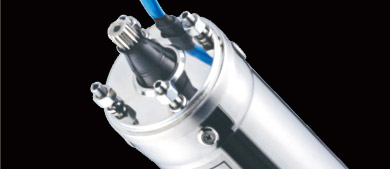Submersible pump installation steps
1. Acceptance of deep well submersible pump: When the user picks up the goods from the logistics company, it should be carefully checked to see if the cable sheath is damaged. Whether the pump is broken or not.
2. Loading and unloading: Care should be taken to load and unload the truck so as not to damage the concentricity of the unit or break the cable insulation.
3. Checking steps before the whole unit goes down the well: A. Disassemble the filter net, use the mast to move the coupling. The rotation should be flexible. B. Fill the electric pump vertically with water, connect the cable joint, and soak the joint with the water basin. The value of the grounding resistance of the joint (the insulation resistance of the single-finger joint to water) is not less than 500 megohms. C. Put the pump in the appropriate container and add the washing powder to the outlet of the pump. At the same time, slightly click the motor start button to observe the steering of the pump carefully. The time should not exceed 2 seconds.
4. Steps of on-site assembly of the water pump when transporting separately: A. Vertically place the motor vertically before installation, open the venting hole and the water injection hole, be sure to open both water blocks, fill the water to tighten the water injection block and the water discharge block. Observe whether there is water leakage in the motor. If there is water leakage, you must not go down the well. The reason may be that the collision occurs during the transportation process. You should contact the agent or the manufacturer to solve the problem in time until it is not leaked (observe 10 to 15 minutes). Then shake the insulation resistance of the motor, the value is not less than 50 megohms. B. Wrap the cable connector. After wrapping, try the steering of the motor. The direction of the arrow marked on the pump is the same, and the mark is consistent.
5. Inspection of the pump when the pump is separated A. Remove the upper casing of the pump to expose the uppermost impeller, B. Turn the impeller by hand to see if it is flexible. C. Pull the impeller in the direction of the pump shaft to observe the total amount of the impeller. General QJ pump 4-6 mm) D. Install the coupling and the motor in one piece so that the motor shaft head and the pump shaft are not tight enough to have a gap. E. Look at the upper and lower enthalpy gaps of the impeller, which should be in the middle of the total enthalpy (permissible deviation ± 0.5 mm). F. When the deviation is greater than 0.5 mm, adjust the adjustment pad to the middle position. The hand should be rotated flexibly. G. Then drill the top hole of the coupling and tighten the top wire to install the upper case. H. Use the mast to toggle the coupling again. The rotation should be flexible for the assembly. Then install the filter and the wire box.
6. Deep well submersible pump downhole: Before the downhole, use a rope to hang a log or steel pipe of the same length (the diameter is equal to the maximum outer diameter of the unit) to test whether the well pipe is straight. In order to avoid getting stuck in the unit when the well is down.
7. Cable tying: The cable should be tied to the water pipe with an insulating cable tie. Do not use wire.
8. Control and start-up of the unit: selection of control equipment. Motor power × 1.2-1.4 times = control cabinet power. The control cabinet should have protection measures such as phase loss, overload, and overcurrent short circuit. After the installation of the downhole, the test machine starts. The start-up time is between 10-25 seconds according to the difference of the motor power. The start-up time of the high-power motor should be relatively long. Check whether the current is overloaded, whether the three-phase current is balanced, and make a record. And feedback manufacturers as the basis for warranty.
9. Overload, overcurrent, phase loss, short circuit, sensitivity debugging: This step is very important, please install the personnel carefully. A. Overload and overcurrent debugging: Rotate the current adjustment knob of the thermal relay slowly to the direction smaller than the actual working current. Rotate a little scale each time, and the interval is about 2-5 minutes until the thermal relay action unit stops working. Then rotate a few scales in the opposite direction. B. Phase loss sensitivity debugging: Start the unit again, and disconnect the fuses of the unit knife switch one by one, so that the unit is in two-phase electric working state. Observe whether the thermal relay can cut off the control power within 5 seconds. C. Short-circuit test: This step is usually protected by the air switch of the power supply system. Generally, no field test (more dangerous) requires the power supply system to be equipped with an air switch (the air switch model is preferred DW10 type, the second choice DZ type).
Le Frog Pump Co., Ltd. is specialized in small submersible pumps, sewage and sewage submersible pumps, sewage pumps, deep well pumps, water mixers, pipeline pumps and other diving products, no negative pressure, voltage, supercharged water supply equipment, Production enterprises for the manufacture and research of sewage lifting devices, booster pumps and vertical multistage pumps. Products focus on practical, innovative, environmentally friendly, economical and efficient.

